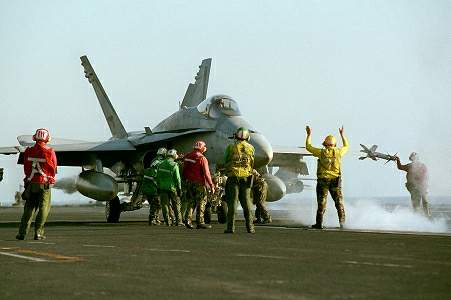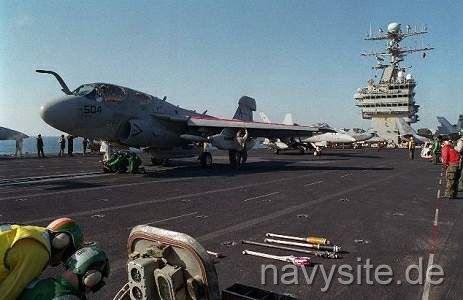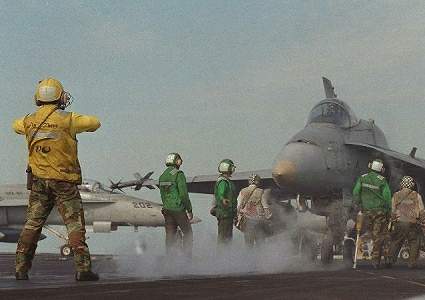

 |
Search the Site with

|
 USS CARL VINSON is commissioned on March 13, 1982. After extensive work up and sea trials, the ship with a crew of almost 6,000 Sailors departed Norfolk, Va., on March 1, 1983, and embarked on an eight-month around the world cruise. CARL VINSON steamed in the waters of the Caribbean Sea, Atlantic Ocean, Mediterranean Sea, South Atlantic and Indian Oceans, South China Sea, Sea of Japan and the Pacific Ocean en route to its new homeport of Naval Air Station Alameda, Calif. On Oct. 28, 1983, CARL VINSON sailed under the Golden Gate Bridge for the first time as it entered San Francisco Bay.
USS CARL VINSON is commissioned on March 13, 1982. After extensive work up and sea trials, the ship with a crew of almost 6,000 Sailors departed Norfolk, Va., on March 1, 1983, and embarked on an eight-month around the world cruise. CARL VINSON steamed in the waters of the Caribbean Sea, Atlantic Ocean, Mediterranean Sea, South Atlantic and Indian Oceans, South China Sea, Sea of Japan and the Pacific Ocean en route to its new homeport of Naval Air Station Alameda, Calif. On Oct. 28, 1983, CARL VINSON sailed under the Golden Gate Bridge for the first time as it entered San Francisco Bay.
CARL VINSON received the highest marks ever awarded an aircraft carrier during an operational readiness examination in February. In March, the ship and crew became "San Francisco’s Own" in a formal adoption ceremony. In May, CARL VINSON participated in RIMPAC ’84, a multi-national exercise involving ships from nations which "Rim of the Pacific" including Canada, Japan, Australia, as well as the United Kingdom. On Oct. 14, 1984, CARL VINSON began a seven-month Western Pacific deployment.
From early January to mid April, CARL VINSON was deployed in the Indian Ocean for 107 consecutive days at sea operations. The carrier received its first Meritorious Unit Commendations for operations conducted from November 1984 to May 1985. In February 1985, the Chief of Naval Operations named CARL VINSON as the winner of the Admiral Flatley Memorial Award for operational readiness and aviation safety for 1984.
In May and June, 1986, the ship was involved in a series of high-tempo operations that included RIMPAC ’86 exercise. On Aug. 12, 1986, CARL VINSON deployed on its second Western Pacific/Indian Ocean cruise and its third deployment in all. During transit west, CARL VINSON became the first aircraft to operate in the Bering Sea.
 After conducting extensive operations in the Indian Ocean and North Arabian Sea, CARL VINSON transited the Bering Sea once again in January 1987.
After conducting extensive operations in the Indian Ocean and North Arabian Sea, CARL VINSON transited the Bering Sea once again in January 1987.
During the transit to NAS Alameda, CARL VINSON received the highest grade ever given to an aircraft carrier during an Operational Reactor Safeguard Examination.
CARL VINSON departed NAS Alameda for its fourth deployment on June 15, 1988, and making another challenging and successful transit of the Bering Sea. The carrier completed 82 days on station in the North Arabian Sea. While on station, the Gold Eagle supported the escorting of American flagged tankers in the Arabian Gulf. CARL VINSON returned to NAS Alameda on Dec.16, 1988. The carrier received its second Admiral Flatley Memorial Award for aviation safety.
The carrier departed Alameda on Sept.18, 1989 to participate in PACEX ’89, the largest peacetime naval exercise since World War II. CARL VINSON conducted operations in the icy waters of the Bering Sea, including operations inside the Aleutian Islands. In the following weeks, CARL VINSON, leading a battle force of three carrier battle groups, conducted operations in the Western Pacific Ocean and Sea of Japan, and were joined by the navies of other nations.
The ship departed on its fifth deployment on Feb. 1, 1990, for the Western Pacific and Indian Ocean. The carrier received its first COMNAVAIRPAC Battle "E" award for 1990. After returning to Alameda on July 3, the carrier steamed to Bremerton, Wash. in September to commence a complex overhaul at Puget Sound Naval Shipyard starting on Sept. 22, 1990, which would conclude on April 6, 1993.
The carrier started its sixth deployment on Feb. 17, 1994, to the Western Pacific and Arabian Gulf in support of Operation Southern Watch. The Commander-in-Chief, Pacific Fleet Change of Command was held on the carrier on Aug. 5 while at Pearl Harbor. CARL VINSON returned to Alameda on Aug. 17, 1994, and received its third Admiral Flatley Award for aviation safety.
 From Aug.26 to Sept. 3, 1995, CARL VINSON participated in Exercise Ke Koa and the commemoration of the end of World War II in the Pacific. During the commemoration, President Bill Clinton visited the ship in Hawaii and 12 historic warplanes from World War II were launched from the flight deck. One month later, the ship returned to the San Francisco Bay area and participated in Fleet Week, ’95, launching World War II aircraft, an
From Aug.26 to Sept. 3, 1995, CARL VINSON participated in Exercise Ke Koa and the commemoration of the end of World War II in the Pacific. During the commemoration, President Bill Clinton visited the ship in Hawaii and 12 historic warplanes from World War II were launched from the flight deck. One month later, the ship returned to the San Francisco Bay area and participated in Fleet Week, ’95, launching World War II aircraft, an
CARL VINSON departed May 14, 1996, for its seventh deployment to the Western Pacific and Arabian Gulf. The ship participated in Exercise Rugged Nautilus and Operations Desert Strike and Southern Watch before returning to Alameda Nov. 14, 1996. The carrier received its second Battle "E," its third Meritorious Unit Commendations and its fourth Admiral Flatley Award.
On Jan. 17, 1997, CARL VINSON arrived at its new homeport, Bremerton, Wash.
Following an intense work up period CARL VINSON participated in RIMPAC ’98. The carrier steamed from Bremerton in early November for its eighth deployment to the Western Pacific and Arabian Gulf. On Dec. 19, 1998, CARL VINSON launched air strikes in support of Operation Desert Fox, and continued support for Operation Southern Watch in enforcing the no-fly zone over Southern Iraq.
CARL VINSON maintained pressure on Iraq by launching several air strikes against selected targets located in the no-fly zone of southern Iraq in support of Operation Southern Watch from January to March, 1999. On May 6, 1999, USS CARL VINSON returned to its homeport, Bremerton, Wash.
In July 1999, the ship entered Puget Sound Naval Shipyard for an 11-month Drydocked Planned Incremental Availability (DPIA). The Navy spent more than $230 million for equipment upgrades, a new local-area network (LAN), new berthings, and several quality-of-life upgrades.
CARL VINSON finished the overhaul period in June 2000 and began the pre-deployment phase of operations. The ship got underway for sea trials, TSTA, FEP, and COMPTUEX in the fall, operating off the coast of Southern California with Carrier Air Wing Eleven and other ships in the battle group.
From January to June 2001, the carrier spent most of the time out to sea preparing for the ship's twelfth deployment. CARL VINSON steamed out of Bremerton, Wash., on July 23, and after stopping to on load Carrier Air Wing Eleven at Naval Air Station, North Island, Calif., headed west. On Sept. 11, as the USS CARL VINSON rounded the tip of India en route the Arabian Gulf, to once again enforce the no-fly zone over Southern Iraq in support Operation Southern Watch. Instead, the Gold Eagle changed course and headed to the North Arabian Sea, where the would be the first to launch strikes in support of Operation Enduring Freedom.
CARL VINSON returned from her historic deployment on Jan. 23, 2002. For their support in the nation's war on terrorism, the crew again received a Battle "E," and a Navy Unit Commendation. In April, the crew began a Planned Incremental Availability. During which time several new operational systems were installed, and the ship’s flight deck and catapults were completely renovated. Numerous other spaces and crew living areas were also entirely restored, drastically improving the working and living conditions for the crew. Work was completed on September 4, 2002.
Following a COMPTUEX and JTFEX in January 2003, the CARL VINSON once again set sail for the Western Pacific to serve as the Navy's presence in the area while the KITTY HAWK (CV 63) was undergoing maintenance work at Yokosuka, Japan. The CARL VINSON participated in a series of exercises including Tandem Thrust 03, and finally returned home to Bremerton on September 13, 2003.
In early September 2004, CARL VINSON again departed Bremerton for a month long training mission in the Eastern Pacific in preparation for a six-month deployment beginning in January 2005.
The aircraft carrier departed Bremerton, Wash., in January 2005 for a Joint Task Force Exercise and after completion of the exercise began its journey west on February 2. Arriving in the Persian Gulf and relieving the HARRY S. TRUMAN (CVN 75) Carrier Strike Group on March 19, 2005, the VINSON operated in the Gulf until early July, when she transited the Suez Canal enroute to Norfolk, Va., where she arrived on July 31, 2005.
On November 11, 2005, the CARL VINSON was towed from Norfolk to the Northrop Grumman Newport News Shipyard to commence her Refueling and Complex Overhaul (RCOH).